The pass
Odon wanted us up and out of the first night’s camp site by 7:30AM. Most of us were up, mostly on time, the porters’ gentle tapping on our tents bringing us back from our exhausted sleep to our location on the side of the trail.
The chickens were scratching at the grass around the tents, and the mist was beginning to burn off. We all tumbled roughly out of our bags and wandered in small groups to the bathrooms, some hacking; some rubbing our eyes sleepily. Then we dressed and pulled our packs out of the tents, redistributing weight, and determining what would be carried by our hired porters. Almost the second our tents were free of gear, the porters had them broken down and packed away. Over the course of the trek we would be witness to the hyper-efficiency that had them simultaneously preparing meals, washing dishes and breaking down or setting camp. Even at our best, we were a half-step behind – simply hanging on enough to get ourselves into the meal tent.
The orange, plastic wash basins placed at the entrance to the meal tent before each meal, were filled with warm water for us to clean our hands and faces. Along with a good tooth-brushing, they provided a comfort, a sense of normalcy as we pawed our way through the mountains.
This morning, we were scheduled to officially meet the porters. Before we all shouldered our loads, we stood across from each other and shared names, professions, ages, and hometowns.
Francisco, the leader of the porters stepped forward. A man of medium-height with a mesmerizing smile and sparkly eyes, he was the representative of the group. He was also the shaman. He would make the offerings that kept our group safe on the trail. He welcomed us and turned to the other porters to introduce themselves. Along with their jobs, they told us their ages. Francisco, at 35, was the youngest. The eldest was 62. He was a tiny, wiry man who we had seen on the trail with a noticeably larger load than the others. When Odon translated this man’s introduction, he explained that the eldest of the group always carries more weight than the others, in order to show that he is still able to shoulder his load.
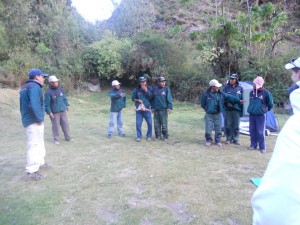
Then it was our turn. I tried my intro in Spanish, looking to Odon for the word for “writer,†and received approving smiles and nods. The porters spoke the local, ancient language, but had more Spanish than English. My effort was noticed. A lot. Francisco interrupted to ask Odon if I was married, hiding his grinning face behind one of the other giggling porters.
The introductions were completed with a cultural exchange. The porters taught each of us a phrase in their language. Things like, “How are you?†and “Don’t get tired,†were repeated as we tried desperately to memorize them.
“Odon, how do you say thank you?â€Â I wanted to be able to address our porters in their own language. Odon looked at us, and gave us the answer. It was something that sounded like “sul pie key.â€Â And then he explained that we should add “wai key†to the end, making the phrase, “thank you, brother.â€
“You see, there is no word for ‘friend.’ Everyone is a brother or a sister.â€Â Beautiful. We all practiced, committing the phrase to our deepest memories so that it wouldn’t escape as we climbed to 14,000 feet.
And that’s where we were headed: Dead Woman’s Pass at just over 14,000 feet above sea level.
“We’re walking alone today. Everyone go at your own pace.â€Â Odon had special instructions for this part of the trek. “You will get tired. It’s okay to stop. Stop as often as you’d like. Walk for 10 minutes and then stop for 10. That’s fine. But don’t sit down. Never lie down.† His face was serious. “If you do that, you won’t be able to get back up. You won’t make it to the top and we’ll have to take you back down. There’s some medical reason. I don’t know, but you need to not stop for too long. Don’t wait at the top for anyone. Just take you pictures and start down the other side.â€
This was more intense than I’d expected. He was talking about blood pooling. It made sense. We’d be a lot higher than our bodies were used to. Blood wouldn’t be pumping as well. Oxygen deprivation was a serious thing.
And with Odon’s words ringing in our ears, we struck out, through the little village, along the trail that would take us to the pass.
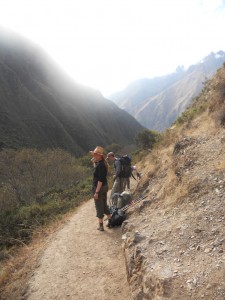
We were about an hour behind Odon’s schedule. He seemed anxious to get us moving. Even with lighter loads, this leg would be the most taxing of the week. We’d been told we’d hiking for 7 or 8 hours. Somehow, I thought this was a hyper-inflated number designed to scare us a little. It was not.
We hiked. And hiked. And hiked. And then we hiked some more, kept company by the imposing mountains, and ever climbing trail.
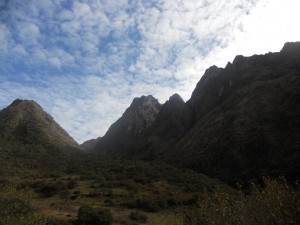
It was three hours before we had any view of the pass. Three hours of walking up the trail, climbing up the steps that seemed too large for small Inkans, three hours of stopping to breathe. When we finally saw the pass, and the line of people, like cliché ants winding their way closer, we all stopped. A bunch of us were heading up at the same pace, leapfrogging each other as we stopped to take pictures, and to suck down water from the tubes that ran over our shoulders from the bladders in our packs. The act of biting the plastic, sucking and swallowing was almost too much to do while hiking. It left me nearly breathless, struggling to catch wind while I scrambled along the path.
I gasped a little when people took off their packs and sat down. I could hear Odon. I could see the blood pooling in their legs. “Do you think we should be sitting?â€
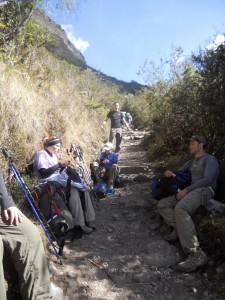
“It’s just for a minute. We’ll be fine.â€
I unclipped my pack and leaned back against the earth wall that was the side of the trail. It was the most I was willing to risk. We could see the top, and that felt good, but we were still another hour away from the last checkpoint, according to Odon. From there it would be another hour or two. I was pretty sure, by this point, that he wasn’t trying to scare us with the 7 or 8 hour number, and probably not with the blood pooling, either.
From then on, we walked for no more than 15 minutes between breaks. The air was thin. It was beginning to get cooler. And the novelty of the trail was wearing off.
The final checkpoint before the pass was in a field, high in the mountains. It sat opposite a lake. A black glass pool, rigid and vacant. The light was bright and the atmosphere strange. Some trekking companies had set their meal tents near the checkpoint. Porters rushed up and down the trail, and burners boiled water in large pots close to the ground.
I took advantage of the bathrooms here. With my pack set aside and my toilet paper in hand, I jogged into camp , past Australian trekkers on their way back from the toilets. “How are they?â€Â I tossed the obligatory question at them as I passed.  “Not bad, actually.â€Â The woman who responded was nodding in an approving way.
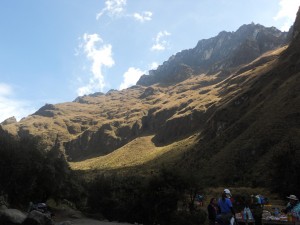
The mood in the camp was a mixture of tired and excited. We were all close. The trail runs one way, so everyone there was headed to the pass, whether under their own steam, or on the backs of the porters.
Once back on the trail, we looked up at the pass. It was right there. Right there in front of us. It looked so very close.
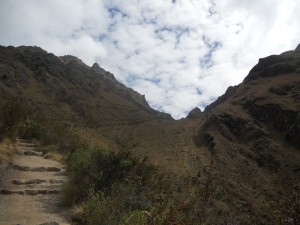
But Odon said it would take another hour and a half to get there. And it did. We were part of a line of trekkers. Most of them were traveling without packs, but moving quite as slowly as we were. It felt good to be keeping pace with them. Good emotionally, but physically I was panting open-mouthed, trying to get as much oxygen to my brain as possible.
Every so often, we’d hear “porter!†and we’d shuffle to the side of the little trail to make room for the men who were running, yes running, up the mountain with unfathomable loads on their backs.
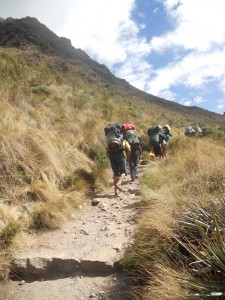
Almost all of them ran in sandals. Shoes made of old tires. The newer porters had blisters. Sometimes there was blood, and rarely it was wrapped. The older porters just had amazing calluses, whether from running the trails, or from working the fields. Most of them were farmers. They would run past us, holding the packs to their backs and disappear over the saddle of the mountain.
We knew we had reached the top, when we found a pile of backpacks and saw a large group of people sitting. The pass wasn’t the tallest peak. It was the way between the tallest peaks. Some people were climbing higher on either side, looking for a better view. Many others were sitting down, taking in the view, and hydrating for the downhill portion of the day.
It’s great when you find yourself traveling with someone who thinks the same way you do. Our moment at the top of the pass was one of those times. LeAnna and I looked at each other and silently agreed that we weren’t going to do what everyone else was doing.
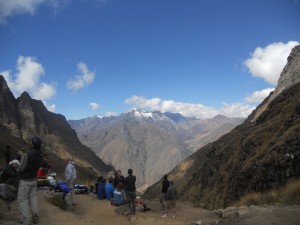
We took our pictures and then gathered our packs and hurled ourselves down the backside of the mountain. This was the perfect opportunity to get in front of the chattering, coughing, packless masses that had beaten us to the top.
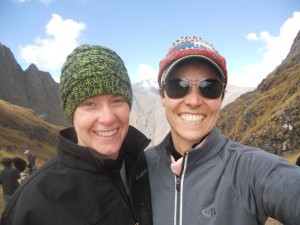
We really did hurl ourselves. Odon had mentioned that the porters run downhill, not only because they need to beat the rest of the trekkers into camp, but because it’s easier on your body to run. I’d known this to a lesser extent from running cross country in high school. But the idea of running with 30 lbs on my back was a little daunting. By this time, we trusted Odon. So we decided to give it a try. Down a gazillion rough-hewn rock steps in the middle of the Andes.
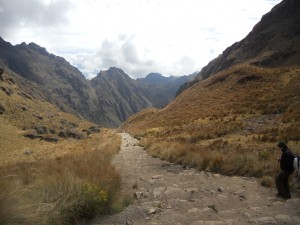
He was right. (Of course he was.) Using our walking sticks to stabilize, it was much easier. We ran, skipped, and bounced down the steps. I swear we saw almost nobody the entire 2 and a half hours we hiked down. It was blissful. The mist that was overtaking the pass was absent on the backside. The trail was open and exposed, lined with low scrub brush, which allowed us to see down into the valley where we would be making camp for the night, as well as the trail we would be taking the next day.
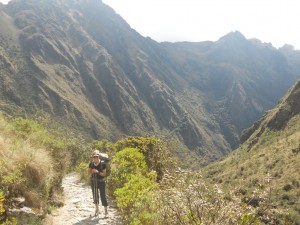
This really was one of the best parts of the trek. LeAnna and I looked around constantly, grinning and giggling. We were running the Inka Trail. We reached our camp before the rest of our group, and before most of the others on the trail. This meant a couple of things: our pick of tents for the night,
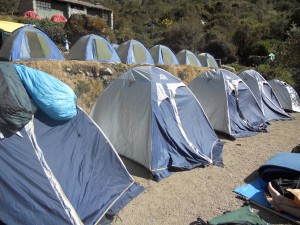
and food served to the two of us in a quiet tent.
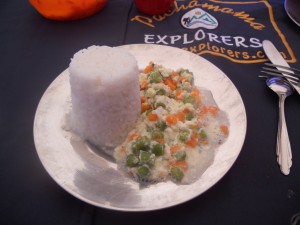
But most importantly, it meant first crack at the bathrooms.
This might sound unimportant, but when 20 women are using one toilet in the middle of the mountains, it’s critical.
We napped in our tent, while the others filed into camp. They’d waited for each other in the thin air. They ate, and we drifted in and out of consciousness. The incredible view of the clouds below us was the best entertainment we could ask for.
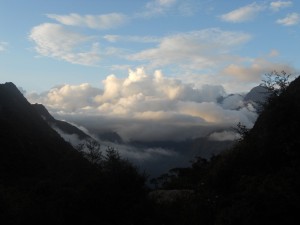
Soon enough, we were eating again. First we had “happy hour,†which consisted of popcorn, pizza, and language lessons.  Our porter, Francisco, was the only one willing to participate. We sat across from each other while our cohorts looked on. I’d point to something, say the English name, and then he’d repeat it and give me the counterpart. It took a moment before I realized he was giving me the Spanish. With a little coaxing, he translated the words into Kechua. I tried to repeat and memorize, but the clicks and creaks that came from his mouth weren’t something natural to me.
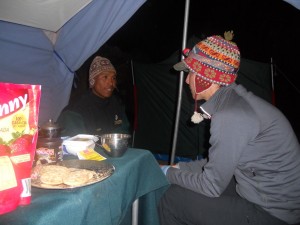
Happy Hour moved into dinner, and we all tried to stuff as many calories into our tired bodies as possible. It was our third meal in 4 hours, and the amount of food on the table let us know that we were expected to be eating a lot. Day 3 was no joke. We were facing a very long day, with climbs, and a 2,000-step descent.
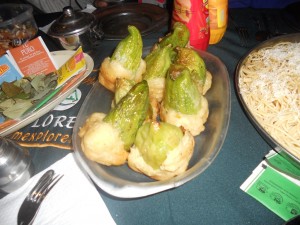
Stuffed peppers, pasta, chicken legs, soups. Odon watched us closely, asking how we each felt, and calculating how much clean water we would need for the next day. Which would begin at 6AM. Today’s late start meant that Odon would have far less patience the next two mornings. And so as the mountains went dark, we climbed into bed, our bodies grateful and our minds quiet.
October 7, 2010 1 Comment
The other Americans
It was early when we got up. Thankfully, the excitement of the trail pulled us out of bed, and the promise of a good breakfast drew us into the dining area.
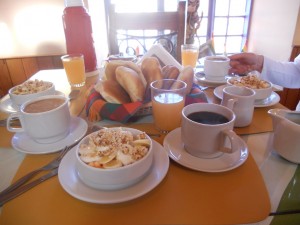
It was 4:30. We had 15 minutes to throw down breakfast and get our bags to the front door for our shuttle pick up that would take us to the start of the Inka Trail.
And that was the goal. The Inka Trail. We were signed up for the 4-day trek that would take us some 29 miles through the jungles of Peru to Machu Picchu. Kelly’s foot was acting up, which meant LeAnna and I would be going it alone. Well sort-of alone. We were trekking with a group – the only way to hike the trail after the mudslides earlier in the year.
During our briefing in the trekking office the night before we’d inquired about the others in the group. There were 5. We got visibly excited when our guide told us there were Israelis, Britts and a German. Then he laughed at us. “No, all Americans.â€Â Darn. We liked our countrymen just fine, but it was exciting to think that we might have some kind of a cultural exchange with the other trekkers.
We climbed into the van at 4:45. It was already filled with our new companions and a couple of our porters, short, dark, smiling men wearing woolly, knit hats with ear flaps and tassels.
LeAnna and I crawled across the second row of bench seats and settled ourselves in for a nap. The others talked animatedly about their trip so far, the beeping watch that one of the girls refused to fix, and about the sickness that had ravaged their group. Seriously? Sickness?
LeAnna and I shot sideways glances at each other. The idea of spending 4 days with a sick person wasn’t entirely appealing. The idea of doing it while hiking to 14,000 feet and sleeping in tents was almost too much.
We drove up and out of Cuzco, watching the villages come alive with workers preparing for the day. After a quarter of an hour of tattling along the roads, we pulled over and one of the porters hopped out. The porters would be carrying our food, and non-personal gear. This guy returned with a propane tank the size of the tank for a barbecue. It weighed 35 lbs according to our guide, Odon. We felt bad for whoever would be hauling that thing. Little did we know…
The terrain was serious. Steep mountains reminded me of the cliffs I’d seen in Japanese scrolls, and the towns nestled in the valleys buzzed with life, streams of smoke rising from rooftops.
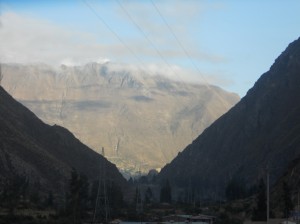
We dozed off and on, LeAnna, our porters, and the other Americans. The small, dark man next to me put his chin to his chest and drifted off, our arms touching gently in the crowded van. Between unconsciousness, I opened my eyes enough to get snapshots of my surroundings. The tall mountains, the deep rivers, the bull rings, standing out like red and white targets.
Our arrival into Ollantaytambo, the starting-place for the trek, was unceremonious. We pulled our little van alongside the enormous tour busses and stepped out into a crowd of swarming, buzzing locals selling their wares. Emergency ponchos, energy bars, rubber tips for hiking poles (I actually bought some of these), everything we could possibly need was pressed onto us as we made our way up the stone streets. We were allotted 45 minutes to shop, use the bathroom, and eat.
LeAnna and I walked away from the crowd and tried to take in our surroundings. We were in the mountains. That was for sure. And there were ruins at the far side of the town: deep steps built into the side of the steep slopes.
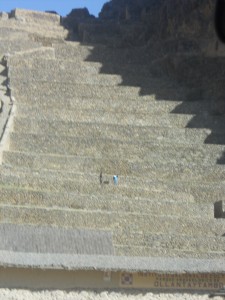
We barely had time to catalog them as we reeled around. The importance of the elements was clear. Not only were the mountains ever-present, the streets ran with swiftly flowing water channels.
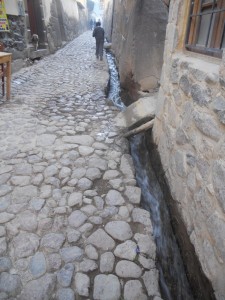
They provided a water-source for every member of the community.
We weren’t especially hungry, but we knew we’d be hiking for something like 8 hours that day, so we decided it was a good idea to eat. We found a funky place, the Living Heart Café, founded by a British woman who wanted to provide education for local children and opportunities for local women. We had quinoa porridge. It was good. Darn good. We scarfed it down, along with a cappuccino (for good measure) and tried to figure out if the other Americans in the restaurant were our trail-mates. It had been so early when we met them that we weren’t sure.
And then we were back at the van for the short ride to the trailhead. There was more talking in the van now, as we drew closer to our next adventure.
At the trailhead, LeAnna and I checked and re-checked gear, discussed our plan for the day, and posed, fresh-faced, for each other’s cameras.
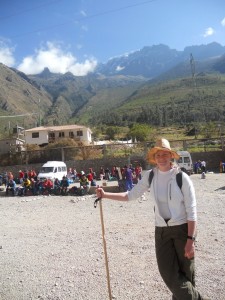
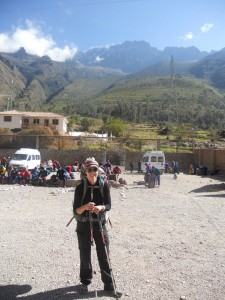
There was much adjusting of packs. When I decided to hike the trail, I decided that, aside from food and tent, I wanted to carry my own gear. It was an issue of pride for me, to prove to myself that I could carry what I needed. I became even more attached to the idea when I found out I was the oldest person on the trek. That’s right, me. At 33, I was the eldest of our group. Insane. So I was hyper-prepared. I had my pack packed tight. I had it on my back , with my trekking poles set. I had coca leaves and tons of water accessible to prevent altitude sickness. I was ready.
When Odon, our guide, called us together, LeAnna and I were first there. We waited as one of the others, in a loud voice, helped his entire posse adjust their packs. We refrained from rolling our eyes, and waited patiently. I noticed how heavy my pack was, and checked that the coca leaves were close by. We were starting the trail at 12,000 feet above sea level.
After our final briefing, we headed to the trail, and paused for the obligatory group photo.
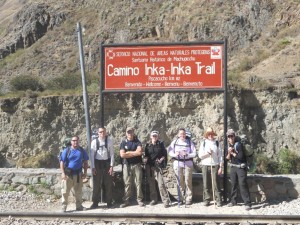
Odon patiently worked through all 6 of our cameras that were swinging from his wrist. I considered the blue skies and the gorgeous mountains. And I reached for my coca.
Now, before the trip I’d heard from everyone who had gone, “drink the coca tea.â€Â I’d decided, however, that I didn’t need to be ingesting a substance; that I could do the trek without. That is perhaps true. However, after spending 3 days in Cuzco, I knew what an altitude headache felt like, and I wasn’t interested in having one on the trail with 30 lbs on my back.
So I took the leaves, which looked just like bay leaves, and I crunched them up. Then I stuck them in my cheek. I stuck a lot of these crushed-up leaves in my cheek. If you are or know anyone who is a tobacco chewer, you probably know that this is not the way to chew a leaf. The correct way, as I would later find, is to take the entire, dry leaf, moisten it in your mouth, and then fold it gently into your cheek.
By the time we’d reached the checkpoint 1/8 of a mile in, my mouth was numb.
“My mouth is numb,†I said, turning to LeAnna. “It almost tastes like Novocain.â€
“Um,†she said, looking an even mixture of alarmed and amused, “that’s what they make Novocain out of.â€
My God, she was right. I spit the green bits out as much as I could, but they were still wedged between my teeth. I didn’t really have time to deal with the coca situation, however, as we were almost immediately climbing. We crossed the Urubamba River and headed up.
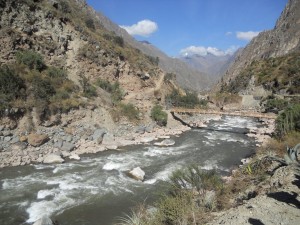
I swear to you, I thought I might very potentially die. I wondered if I’d have a heart attack, if I’d black out and fall off the side of the cliff, or if my body would simply give up. We were 5 minutes into the trek. It wasn’t good.
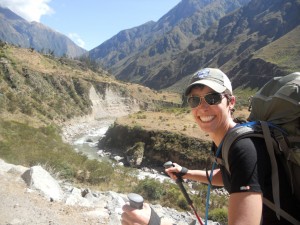
I don’t know how, but I managed to muster one last grin as I was gasping for air and trying to settle my thundering heart. I was honestly afraid for my physical wellbeing, and equally afraid to show how much trouble I was having.
But the trail leveled out, and I was able to catch my breath – roughly. I was still a little distressed by the pace that Odon was setting. I was in pretty decent shape, but I hadn’t been training at high altitude, and I hadn’t been hiking for 8 hours a day, nor with a big pack. LeAnna seemed okay, and the others weren’t far behind us. One big voice was booming on, but everyone else seemed to be quieting down. Maybe they were experiencing the same shock I was. I don’t know, I was focusing on breathing.
Twenty minutes in, we hit the first checkpoint. It was a bend in the ancient rock trail where local vendors had tiny stands selling Gatorade and toilet paper. We sat in the shade of an enormous avocado tree. Odon pointed at the fruit that was the size of my hand and told us it was small fruit. “In a month there will be a hundred of them, this big.â€Â He held his hands to indicate something the size of a small cantaloupe.
I looked around at the stray dogs that, even here, were ubiquitous. Â Â A tiny, three-legged dog hobbled around, more at ease than I was.
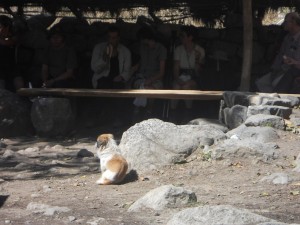
I chuckled to myself.  Great sign for what was ahead.
We left the checkpoint after a 15 minute water break, Odon in the lead.
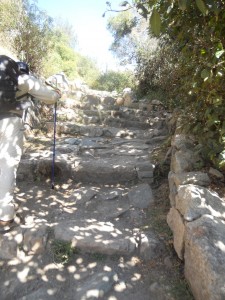
All thoughts of a “paved path with handrails†were abruptly shoved from my mind. Whomever had told me that I’d be disappointed at the commercialization of the trail had no idea what they were talking about. For real.
Another half an hour on, we came to our first archeological site. One thing I hadn’t expected from the trip was all of the archeology. I thought we’d hike a long-ass trail and then arrive at Mochu Picchu. The sites that we visited each day were a brilliant surprise.
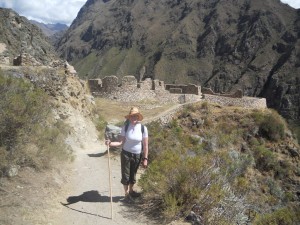
From this site, we looked down onto a bigger site, and across the river to one of the original Inka trails that connected the great, ancient cities of the Inkan empire.
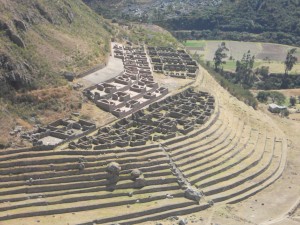
We spent some time wandering around the site, listening to Odon’s explanation and marveling at the enormity of where we were.
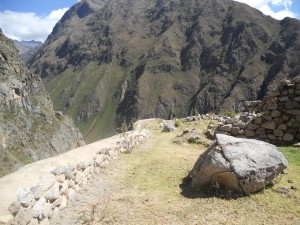
Then we headed on to lunch. We hiked another hour before we saw the green and yellow of the food tent that would serve as a beacon for the next four days, signaling rest and food were near.
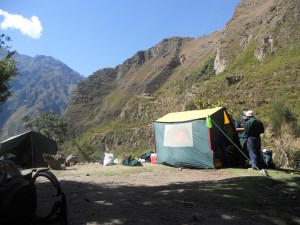
Our beautiful porters were responsible for carrying the common gear. The tents and the plates and the food. They literally ran ahead of us with ridiculously-huge packs on their backs and set up for us, preparing beautiful meals. We tossed our packs onto the tarp that was lovingly laid out for us, hurled our bodies onto the packs, and promptly, and collectively fell fast asleep.
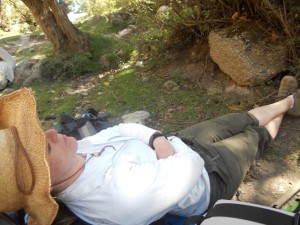
I’m not sure if the smell of the food or the porters voices woke us up. We dragged ourselves up from the ground and into the little tent. The food began simply with bits of garlic bread and corn soup. And then it became a huge tray of saffron rice, stuffed avocados, and a cheese pudding.
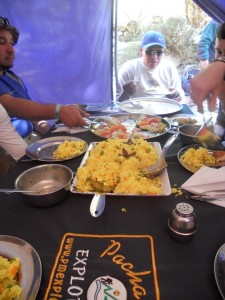
It was clear that my concern about eating as a vegetarian was unnecessary. Even though they carefully prepared egg dishes for me whenever the others ate meat, I would have been more than fine eating all of the other food that graced the table at every meal.
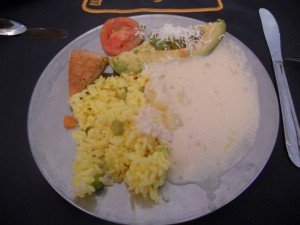
The meal, like every meal, ended with tea and coca leaves. I was the only one to add the leaves to the hot water. I had no intention of feeling the way I had earlier in the day. I grabbed a banana, and stuffed it down. I also had no intention of running out of steam on the trail.
We had at least another 3 hours left on the trail for the day, and though we could have lain down, each and every one of us, and slept through the night, we had to shoulder our packs and head on. This was the test day. Odon was watching us to see who would be able to make it over the pass, and who would be sent back. This wasn’t a test any of us wanted to fail.
The trail meandered up and down, and we all walked together, more or less. Odon would stop us every so often to wait for those who were taking a little longer, or to sit and talk with a friend along the trail.
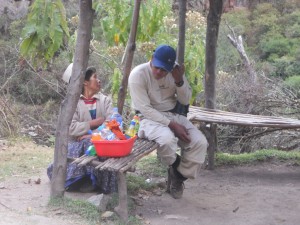
Odon was fascinating. He had spent years as a porter. Carrying the packs of other people up and down the trail. Now he hikes the trail once a week. ONCE A WEEK. We did some quick math and figured that he’d hiked the trail something like 500 times. That, my friends is amazing.
The terrain changed a bit from dusty plains to high-steppe. The sky continued to shine a startling blue, and the snow-capped mountains got gradually closer.
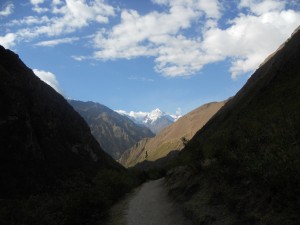
Our first-nights camp was in a village. A very small village on the side of the trail. The company had an agreement with locals to camp in what appeared to be their backyard. Chickens, big ones, ran around the tents, looking for handouts as we claimed our sleeping quarters for the night, and admired the view.
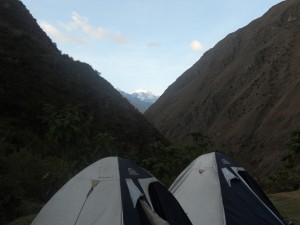
After another brief nap, and foray to the bathrooms (the bathrooms on the trip will require an entire and separate post), it was time to eat again. This time it was popcorn, potato soup, alpaca, eggs, and jungle potatoes – an extremely starchy potato that I was sure was filling us with energy for the morning.
Odon let us know that the Porters were monitoring how much we ate. Not only was it more weight off their backs, it was an indication of whether or not we’d be able to make it over the pass. We weren’t eating enough…so I reached for another potato or two.
Then he informed us that we could hire porters for the next day’s hike. The big one. Ten hours, summiting at 14,000 feet. If we wanted, he would arrange for porters to carry our bags. I’m not going to lie. I considered it. I asked him if I could make it and he said yes. He also said that there would be others coming back down the mountain tomorrow who wouldn’t. That he’d seen them and he knew who they were. When we asked how he knew, he said they had a different, “flavor†about them.
Then he told one of the guys in our group that he would have to hire a porter. And that it wouldn’t be a bad idea for one of the women, the one who was sick and coughing most of the time, to hire one as well. It was a blow. We could all feel it. Nobody wants to be told that they can’t make it on their own. But he was right.
By the end of the night, two porters had been hired. They’d be carrying two packs. They’d also be carrying the extra sleeping bag that I was carrying for LeAnna. We were traveling with one big bag and one smaller one, our gear consolidated. We’d planned to switch off, but I was holding up well, except for the blasted sleeping bag. It was rented from the trekking company and not designed to be light. I was glad to hand it over.
It was pitch black when we climbed into our tents. Each of us had our little headlamps lit for the brief time it took to crawl into the tents. And then it was black. Blissfully dark and quiet. The hard ground under us was lost as we drifted into sleep.
September 19, 2010 1 Comment
Cuzco is for addicts
We got into Cuzco early. It was about 8AM when our driver dropped us at our hostel. I’d never stayed in a hostel, and images of bunk beds and shared showers had me a little worried. But when we walked through the blue doors on the steep street, into a beautiful courtyard, I stopped worrying.
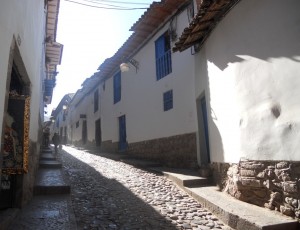
The woman at the front desk took our passports and spoke with Kelly in Spanish. We designated Kelly our primary Spanish speaker, because she’d been studying the most. She was so eager to speak, that even when the other woman told her she could easily speak English, Kelly refused. So LeAnna and I listened and nodded along as Kelly confirmed our reservation and bought 3 huge bottles of drinking water.
Because we were there so early, the room wasn’t quite ready, so we tossed our bags in a corner and struck out to see the city.
Cuzco is high. It sits at 12,000 feet above sea level. I grew up at 7,000, with regular trips to 9,000, but the only time I spent above 12,000 was on Hawaii’s Mauna Loa for my 30th birthday – where we all became giddy from altitude sickness. As we toddled out into the streets, it was with awareness of the distinct shortness of breath that accompanied the clear, blue sky.
We made a circuit around our part of town, stopping at the train station and airline office to confirm parts of the next leg of the trip. Kelly and LeAnna would be continuing on to Lake Titicaca and the Amazon. While they talked timetables and layovers, I consulted Kelly’s guidebook, and dozed lazily in the plastic chairs of the waiting areas. I located the Plaza Armas on the map (the main historic square) and read about its history. Then I turned to the really important thing: food. I had no interest in eating llama, or the local staple, cuy – guinea pig.
There were pizza places everywhere (I’m guessing because the wood-fired ovens used for cooking the cuy are a natural fit for pizzas). The guide book suggested an interesting place off of the plaza, and I filed it away for later.
We tramped through the streets in a jet-lagged haze, making our way to the plaza.
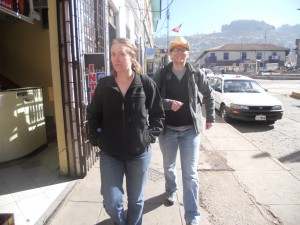
The light seemed strange. Filtered, somehow. It was bright and made the morning feel much later than it was. The streets of Cuzco were coming alive, its cobblestones reminiscent of, but more raw than those of Italy.
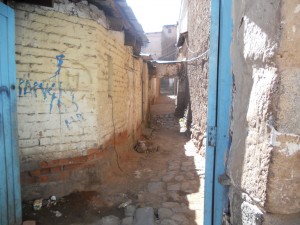
The lanes offered beautiful scenes of daily life mixed with simulated authenticity.
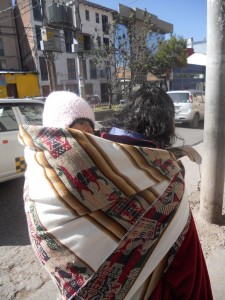
Mothers carried children of varying size and age under blankets wrapped tightly around their backs, little hats poking out from the bundles. I covertly snapped a shot of what was remarkable to me, and completely commonplace to the locals.
Then, just off of the plaza, I saw something colorful and furry.
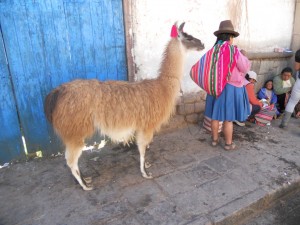
When I ran over to take a picture of an “authentic†Peruvian with a llama, I didn’t know that I was supposed to pay for it. These women make their livings selling snapshots of their clothing, animals and weaving.
The plaza offered great views, bounded on two sides by enormous churches that had competed for the Vatican’s attention and the Pope’s declaration of “most beautiful.â€Â The cathedral (the Pope’s choice) was built on the base of an Inkan temple. The other was a Jesuit church.
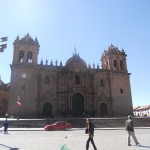
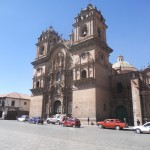
We had a look around at the brown, brushy mountains and the images of pumas everywhere, scoping out a good place to sit.
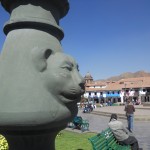
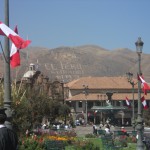
The guidebook said that the plaza still served as a marketplace. By sitting in a park bench, you could avail yourself of vendors. Paintings, jewelry, knick-knacks, tours, paintings, massages and all other manner of items were pedaled to us, as we claimed our view on the plaza.
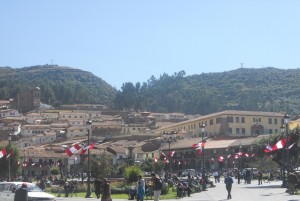
We became more comfortable talking with the vendors. Unlike the vendors on Italian beaches, these vendors would take the time to let us look at their wares, and then move along when we declined, with a polite, “maybe later.â€
The maybe later made us laugh a bit. The third time we heard it we realized that it was ubiquitous.  We decided it must be a way to keep the conversation open for the next time we entered the plaza. Because the vendors remembered us every time we entered the plaza.  “You remember me? I showed you paintings yesterday. I am Pablo Picasso!â€Â The young men sold mostly paintings. The women crafts. Silver jewelry and carved gourds. Textiles and postcards, and everything under the sun, pulled from bags and displayed one after another with immense patience.
With one woman, the most assertive vendor we met by far, I tried out my theory. After looking at her carvings, I smiled and said, “maybe later,†thinking I was politely ending the conversation.
“Maybe later is no good for me, lady,†was her response.  I think I burst out laughing as my self-designated cultural awareness was flung out the window.
The morning nearly over, we headed back to our hostel, stomachs grumbling.
Our front desk friend greeted us with a big smile and a grinned, “como estan?â€Â Our bags were already in our room, and all we needed was our key, which was turned-over heavily to Kelly.
She took command of the huge skeleton key and we made our way up to our second floor room overlooking one of the property’s courtyards.
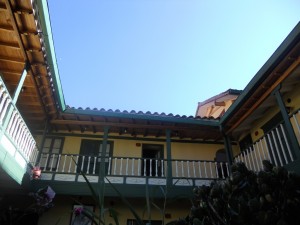
Then we spent some time figuring out the surprisingly complex locking mechanism
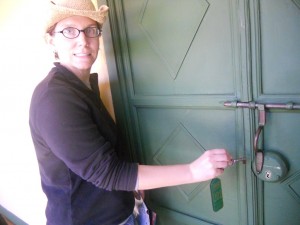
By the time we got in the room and threw down our gear we were appropriately hungry. Working together we came up with a fantastic meal of almonds, dried peaches and an Italian pecorino cheese that I’d smuggled out of Italy and into Peru.
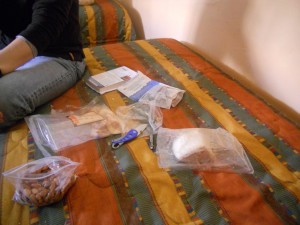
Other places have things that the US doesn’t have. Rooms for more than 2 single travelers, for instance. Our room had four single beds. We each claimed our own and designated the fourth as the gear bed. Then we marveled at our accommodations. Along with the four beds, we had our own, private bath, internet access, breakfast, and all the coca tea we could drink. All for $55 a night. Total.
But back to the coca…
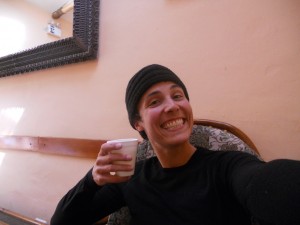
When I told people I was going to Cuzco, they all said the same thing, “drink the coca tea.â€Â I like tea, but I don’t like introducing my body to new addictive substances. Just doesn’t seem like a good idea. So I’d planned to tough it out without the benefit of the coca. But the shortness of breath, sleepiness and vague head pain I was experiencing, along with the pots and pots of coca tea provided by the hostel convinced me that I might be better off joining the locals.
And I was.
LeAnna and I sipped the tea, while Kelly, who would not be spending the next week hiking, looked on. We had no interest in finding ourselves with altitude sickness two days before the four-day trek that was ahead of us.
The tea is made from coca leaves – that’s coca, not cacao – the leaf from which cocaine is extracted. It lowers the blood pressure, and allows your body to absorb oxygen differently. So, in effect, we were doping up for our trek. It did the trick with our headaches. Tea in hand, we all moved into the second, terraced courtyard where scores of traveling students were clutching their own styrofoam lifelines and taking in the mountain air. After a couple of cups, LeAnna and I found ourselves lounging in the sun, our hearts beating insistently in our chests.
Beating aside, we were sleepy. The 20 hours of travel finally caught up to us, so we soon headed to our bunks for a high-altitude nap. In our little beds, we crashed. My last thoughts were of the blood rushing through my heart. LeAnna, on the other hand, was graced with dreams of falling off of cliffs. The coca tea was potent. Kelly slept like a baby.
When we awoke, the day was moving into evening, which meant we could head to dinner. Yay. We pulled out the guidebook once again and I found the restaurant I’d identified earlier. The addicts in us were most excited about a good cup of coffee (because we needed more stimulation), and the “cultural center†atmosphere promised in the book sounded interesting as well.
Books lie. Or they become outdated at an alarmingly fast rate. We found the restaurant, and climbed the spiral staircase to the second floor. We were the only ones there.
We looked out the top floor window onto the streets, and then looked at each other.
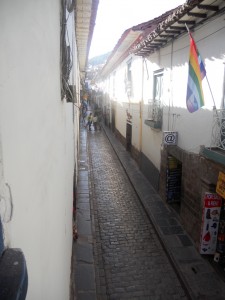
Maybe we were just early for dinner. Maybe there were new owners. Maybe it would pick up.
We were game for staying, but only because we were hungry and had no other lead on food. And we wanted Peruvian coffee. “So, do we drink the coffee?â€Â LeAnna asked the strange question and we looked at her quizzically. “Well, it’s made with water, and I’m pretty sure they haven’t boiled the water for 10 minutes.â€
Damn. None of us had considered this. Parasites weren’t on the list of things we wanted to take home from Peru, and the drinking water wasn’t safe.
A quick debate ensued regarding the drinking of coffee. LeAnna and I came down on the side of “screw it, we’re in Peru, we’re drinking the damn coffee.â€Â Kelly came down on the , “can I have a sip†side.
While we waited for our coffee, we checked out the menu. Along with cuy and other, unidentifiable items, there was a pizza list. Which sounded delightfully comforting. We were adventurous, but hungry. After discounting local fare, we ordered my personal favorite: pizza with olive and pineapple. Delicious. The olives turned out to be Kalamata, a change from the usual, but tasty.
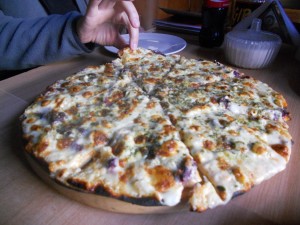
And the pizza was good. Surprisingly so. We gobbled the pizza and slurped tentatively at the coffee. Which was divine. All thoughts of what could be lurking in the water was tossed aside as we tossed back the beautiful-smelling elixir.
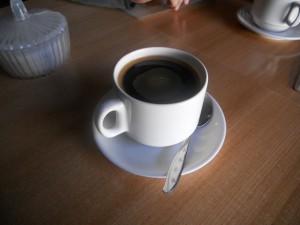
And as we tossed back, we looked up to find the strangest part of the place.
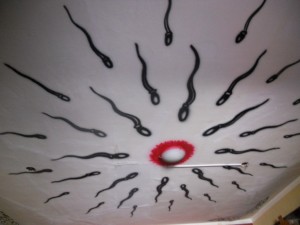
Sperm. Fertilizing a ceiling lamp. Yes, that’s what I said. I don’t know. I didn’t ask. We’re assuming this is the “cultural center” to which the booking was referring. Who knows?
Our stomachs happy, we sat and considered the rest of our time in Cuzco. We’d need another place to eat.  And we might need dessert. While we were a little hesitant to consult the guidebook again, we weren’t ready to accept the recommendations of the hoards of barkers trying to bring in business from the streets.
The guidebook listed a European bakery. A place where we could get more coffee and a piece of cake. Potentially perfect.
Kelly needed an internet café, so we worked our way down the main street, searching for a shop that looked both legit and safe. At every corner was clogged and we were barraged by women with handbills asking if we wanted massages. “Maybe later,†we answered, and they agreed.
When Kelly entered the back of a shop, LeAnna and I sat waiting, catching up on each other’s lives, and musing about the days ahead.   Sitting there talking about the emotional and the mundane, we were treated to a preview of the camaraderie that would thrust itself upon us as we made our way through the truly foreign experience lying in wait.
And then we were walking again, through the streets of Cuzco at dusk, past murals of a maturing justice, and fountains and tourists and locals. Toward pastry.
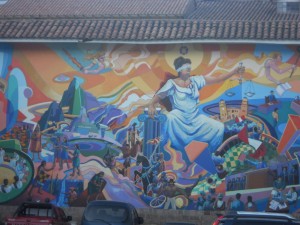
We would visit the pastry shop every night that we spent on Cuzco. We would order a total of 10 desserts in the three visits. Nine of them would be delicious.
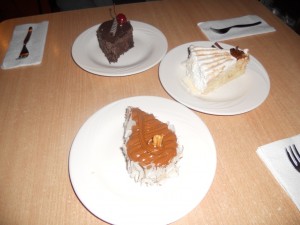
The shop was lovely. White-shirted, black-aproned Peruvian boys waited by the door, hands clasped behind their backs, their dark hair and eyes sparkling at the mix of locals and tourists streaming in and out.
Our three desserts and coffees were consumed, and we laughed lightly, comforted by the familiar look and feel of the place. Caffeinated and sugared, we stepped out into the dark plaza in front of yet another ornate church, where we found a backlit Mary standing watch.
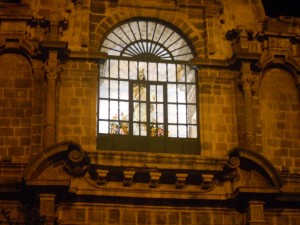
Odd churches were nothing new to me, and I was interested to see the Peruvian flair overlaying the Catholic basics. Kelly and I stepped inside to find one of the strangest church interiors I’ve ever seen. A couple dozen life-sized saints stared down at us from high niches. Wooden or ceramic, each of them was dressed in real clothing. Satin, lace, wool. They all had complete textile clothes. Some had jewels. I wouldn’t have expected this to be so strange, but it really was. Instead of the feeling of benevolence I have felt from the carved statues of saints, this felt like life-sized dolls staring at us as we made a circuit of the large church.
LeAnna, who had wanted to be culturally sensitive, came in to see what was taking us so long. I’m sure we had wide eyes, due to caffeine overload, and the strangeness of the scene.
We weren’t far from our hostel, just on the other side of the Plaza Armas. Despite our sugar highs, we were starting to fade. As we walked back, the night took on a fuzzy, sparkly feeling, the scooters rattling past us along the ancient stones.
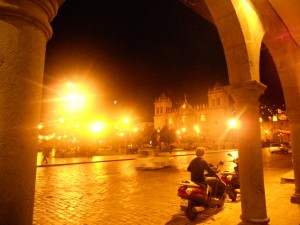
August 16, 2010 2 Comments
Market of the Farmers
Decatur has a “Farmers Market.† It’s not Portland, so it’s not like our farmers markets. I mean, I’m sure there are farmers who produce the products, but I’m not actually sure they ever go to the market. Still, there are some pretty visual things that happen there.
Here are some of them:
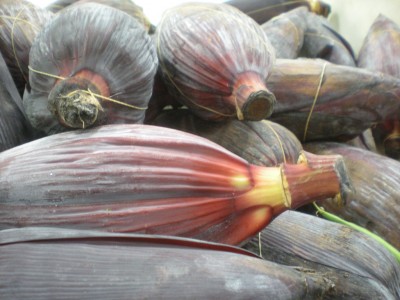
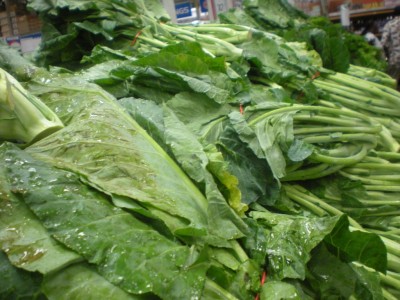
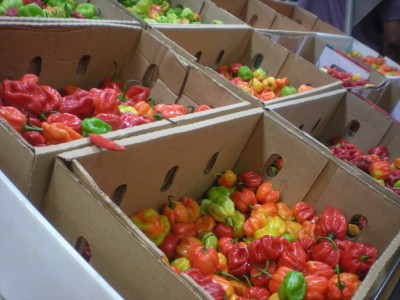
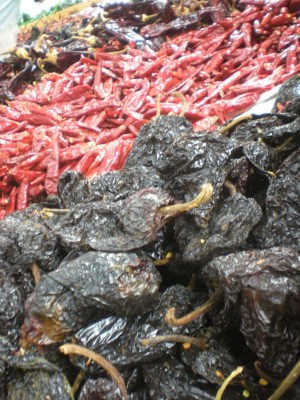
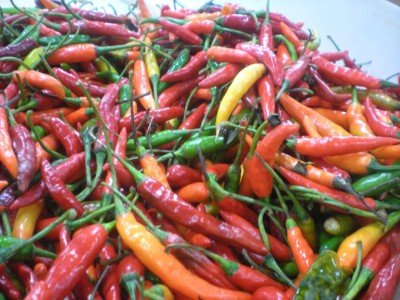
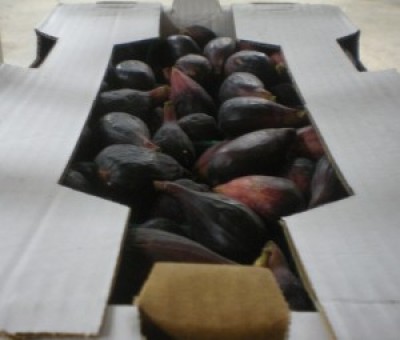
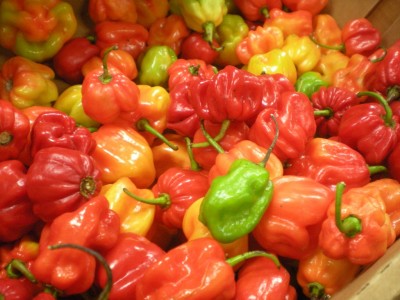
Yummy.
July 27, 2010 5 Comments
Stone-shocked
I’d heard about Stone Mountain. On my last trip to Atlanta 6 years ago. More in passing conversation, as an inside joke that I didn’t get. “Some people are going up to Stone Mountain tomorrow.â€Â “You going?â€Â “Yeah right.â€
“What’s Stone Mountain?â€Â I’d asked blindly.
A few people stared at me while someone answered flatly, “It’s like a Confederate Mount Rushmore.â€
I’d been intrigued ever since. That intrigue was only heightened by the episode of “Undercover Boss†that included a stint at the amusement park that surrounds the landmark, focusing on the WWII duck boats that shuttled visitors through part of the park.
So when Kelly, the friend who had instigated the Peru trek we were about to embark upon, handed me her keys and a map and told me to head out to Stone Mountain for a bit of hiking, I was totally game. “See what time the laser show is,†was her only instruction.
She’d bought the season pass to the park as part of her preparation for Peru. Stone Mountain, with its strange geography was a good place to get some uphill trekking in. But an Achilles injury had kept her from using the pass fully, so she was eager to have me take advantage of it.
I studied the map, and headed out. The mountain was about 30 minutes away. As I drove, I sang to the radio, watching a bubble in the Earth’s surface growing.
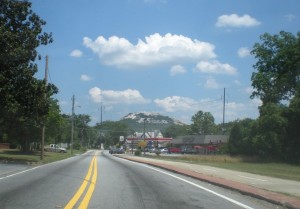
The further I drove out of the suburb of Decatur, the bigger and louder the trucks became, and the further from home I felt. I know it sounds cliché, but it was my experience. At about 40 minutes, I looked in my rear-view mirror and saw the mountain. Crap. I’d sung myself right past the place. I turned around and hoped I’d be able to use the bubble to navigate myself back. Even so, I wasn’t completely sure which turn to take to get to which gate. My usual half-lost-but-okay-with-that self was fading a bit as the monster trucks seemed to crowd nearer to my little Acura at stoplights.
I found my way back to the village of Stone Mountain, and wound through the streets toward the stone. After a couple of wrong turns within the park, I located the right parking lot and a sign to the trailhead.
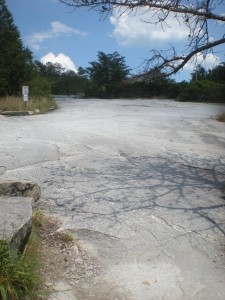
Which wasn’t much of a trailhead. Just a stone face. I paused for a moment to see where other people were going. And they were going up. Straight up the stone. I followed them, interested in a new adventure, and struck by the really strange geology of the place.
Green scrub reached out, sending fingers of scratchy brush along the stone face. Trees grappled with the ground, finding a hold. Great swaths of smooth stone were exposed from the thunderstorms that hit the place regularly.
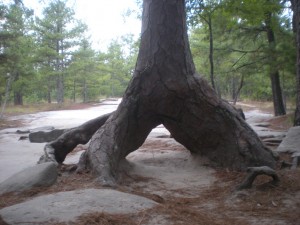
Bobbing along through the scrub, I looked around, side-to-side, up and down, taking it all in. This wasn’t so bad. Strange and all, but still… And then, about 100 yards in, I froze a little inside.
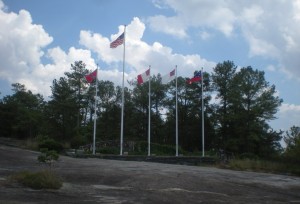
Yes, I know the Confederate battle flag is a symbol of independence; of rebellion. But where I come from, it means more than that. For a lesbian alone in the woods, it means quite a lot. My ex-girlfriend of 4 years was from the south. From Alabama. And she’d tried to explain the flag’s significance. I’d never really understood completely. It was like trying to understand the utility of the pink triangle.  I was curious, but uncomfortable. I looked over at the display of flags, considered stopping, and then sped up, happy to move out of the clearing, and wondering what else I might find.
What I found was a moonscape. It is, quite literally, like nothing else I’ve ever seen. The “mountain†seemed to be dropped out of the sky, or left behind by an incomprehensively large glacier.
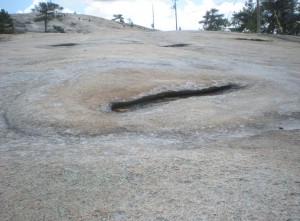
Pitted and strange it stood, as people, like ants, climbed its face and carved their loyalties into its side.
I climbed with them, wondering if they could sense my unease. I climbed with trail runners, and German tourists. I climbed with families, black and white, who seemed either oblivious or unconcerned with the blatant history of the place. I wondered, blithely, whether I’d take my children to an anti-gay monument to go hiking.
The top of the mountain is large, and flatish, the edges dropping dramatically to the greenbelt below. I did a circuit, looking over the side, wondering where the Confederate generals were carved. Until I found what I was pretty sure was the place, based on the grand, grassy viewing area below.
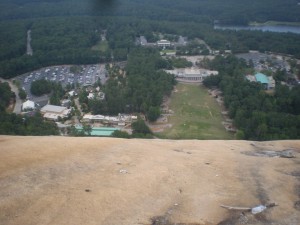
And the gondola platform.
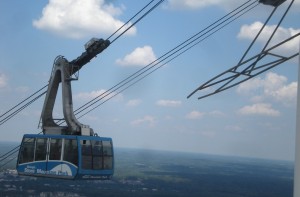
With the gondola shuttling people from the ground to the top of the stone. For what, I’m not sure. I’ve ridden the tram in Portland just to say I rode it, and to see the views on the way to Oregon Health Sciences University. Maybe it’s kind of like that. I’m not sure. Or like riding a ski-lift to the top, in order to see the view. And I have to say that the views from the top were spectacular. It was as though I was looking down on the city from a meteor. It’s possible that I was.
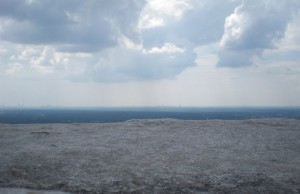
The place was strange.
Have I mentioned that? The geology alone was strange enough. Smooth sections, then great pits, then strange bumps adorned the surface.
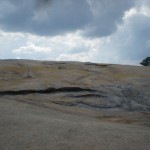
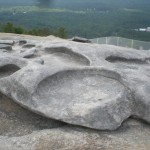
Normally, I’d find a quiet spot, sit, and commune with nature for a bit. But I felt unsettled in this place. It reminded me of the feelings I’ve had when I’ve visited prisons. As a 6th grader on a field trip, or an attorney for the state. There’s a violence in the air. A stripping away of something. A deep unrest sat about the rock, and I couldn’t tell whether it was the people, the weather, or the place itself, churning with a displeasure. I watched the skies change, and the vultures circle. And then I made a break for it.
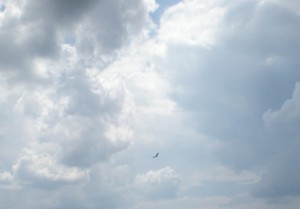
As I jogged down the stone face, the rain started, dotting the thirsty surface, and making everything incredibly slick. Only once did my shoes fail. On the steepest part, I slipped backwards, arms flailing out to grasp the handrails that jutted from the steep ground, waiting to catch unwary visitors.
When I reached the flags again, I decided to stop. The rain was coming down lightly, and my curiosity was even greater than before. I carefully read the placards in front of each flag, considering the combined history. The frustrated history of mistaken identity: Stars & Bars was changed to the battle flag, so as not to be mistaken with Stars & Stripes in a fight. The battle flag incorporated into the white field of the second national flag, which had to have a vertical, red bar added later, so as not to be mistaken for a flag of truce.
That’s a rough history for a movement. Seems a little confusing. I tried to commit it to memory, as I walked the last bit of the trail to the parking lot, past the African-American families headed up the mountain with beach chairs under their arms.
Before I left the park, I wanted to see the carving. I know very little about the Civil War, other than I was taught that it was about slavery, and my ex was taught that it was about trade embargos. I couldn’t tell you who the heroes of the war were, or where the important battles happened. But I still wanted to see the generals carved into the side of the stone.
I drove around the edge of the park until I saw a sign for the plantation and the “memorial lawn.â€Â It sounded promising. I walked past the boarding area for the gondola, where Star Wars music was being pumped like IV fluid to the excited families waiting to fly to the top, through a whitewashed colonial-style building that vomited air-conditioning into the Atlanta heat, and out onto a viewing area.
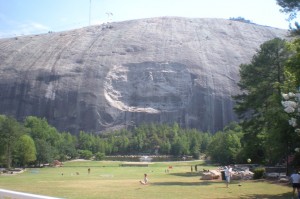
Stonewall Jackson, Robert E. Lee and Jefferson Davis rode across the face of the rock, their horses given equal billing on the informational signs.
I stood there, battling my fight or flight response. Fascinated. Petrified. Now, I’d like to make it clear that I’m an intelligent person. That I’m fairly rational. That I have deep interest in things that are different from my experience. I often seek these situations out, ready to confront my unease. But here, the unbelievable discord of the place crept into my cells. It still does when I think back on it. And I couldn’t find a way through it.
So I tried the nature path. The path led past flags of the confederate states. Scarcely little information was provided. Too bad, really. I was happy to learn more. But I’d have to do it online. I walked down to the front of the lawn and back around. I saw the scenic railroad cars filled with tourists. I saw the high-ropes course and the recreated “Crossroads†town. I saw the white families playing volleyball in the shadow of the mountain, and the young black men wearing “Stone Mountain†polo shirt uniforms as they staffed the attractions.
And then I left. Uncomfortable, but curious. And excited to talk with my Atlanta friends about what all I’d observed – sure I was missing some major dynamics that would help it all make sense. (In fact, as I write this, I’m sure there are people who will be willing to tell me how I got this all wrong, and why, exactly, this is understandable. And probably how racially and socially insensitive I am. That’s great. I’d like to know.)
Only, when I got back to the house, my Atlanta friends looked at me like I was a small child, unable to really understand. “Am I missing something?â€Â I asked, after describing the black workers and picnicking families.
“Hmmm,†is about the extent of what I got in response.
I tried again a few days later with another friend who had grown up there. “We’re thinking of going to the laser show at Stone Mountain. Want to join?â€Â The Stone Mountain laser light show is legend. Confederate glory lasered on to the face of the mountain and set to classic rock. According to the website, there also seemed to be some kind of tribute to Elvis. My friend was not interested.
“It’s just a bunch of rednecks,†was her response. She didn’t go much beyond that when I probed further. I didn’t find that response especially helpful.
It wasn’t until I posted about my experience on facebook that I got anything more. A law-school classmate who had grown up in Atlanta, and happened to be African-American, responded to my “am I missing something here?†post.
“No, not missing anything. That kind of crap is just so engrained there that people don’t notice it … It’s still very much the old south for much of the population mentally. Took me leaving to realize how truly creepy the laser show is (or even just the carving by itself). Like I said, issues.â€
Indeed. When I googled Stone Mountain, I found out that the man who carved Mount Rushmore had originally been involved in the carving of Stone Mountain. Interesting enough. I also found out that the KKK had re-org meetings on the top of the place. You know right around where the tram lets people off to visit the gift shop. And the snack shop.   I think maybe society has some issues. Or maybe I have some issues. I don’t know. But, for the first time, I found myself unable to understand. Unable to come up with some storyline that made sense of what I was seeing. But I guess it made sense to the German tourists. I don’t know. I just don’t know.
July 26, 2010 3 Comments


